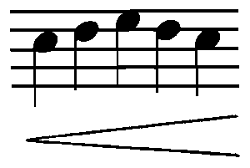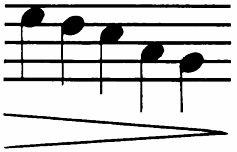This week, we continue on our valiant quest to understanding musical notation.
Let’s begin with a musical convention dealing with note duration that I failed to cover last week: tenuto ties. These are curved lines used to connect notes of the same pitch, often across barriers like measure lines, to indicate that their lengths are to be combined into one longer note.

Whew. Alright. If you read last week’s post, you are now able to read notes and understand their pitch and duration, as well as the time signature schema. You can “play all the right notes,” and hopefully at the right time. This week, by contrast, we will focus on conventions which tell a musician how to play the notes.
First up: articulation! Articulation in music is about what happens between notes. The attack, release, and amount of space between the notes are essential components. But, what do I mean by this, exactly? Let’s look at some examples.
Accent. This miniature “greater than” symbol indicates that emphasis is to be added to the note–typically achieved with greater volume and a more forceful onset–which makes it stand out from the rest.

Staccato. This simple dot indicates that the note should be short and detached, allowing space between it and surrounding notes.

Marcato. This upside-down “v” indicates that the note is to be “hammered” (as this is the meaning of the Italian word from which the symbol’s name is derived). A marcato note is loud, forceful, and typically short–an accent-staccato hybrid if you will, but with a little more “umph.”

Tenuto. This horizontal dash indicates that the note is to be played with its full duration value–long and smooth, flowing into the next note.

Next up: dynamics! Dynamics refers to the volume of musical passages.
Dynamics are written with a spectrum of notation, pictured below. A few notes: Dynamic markings are relative to one another and to the composer of the piece. Pianississimo (ppp) and fortississimo (fff) are also used to indicate an even wider range of volume.

Crescendo. This elongated less-than symbol indicates a gradual increase in volume of the passage above it.

Decrescendo. This elongated greater-than symbol indicates a gradual decrease in volume of the passage above it.

Note: Crescendos and decrescendos can be placed back-to-back. Crescendos are sometimes placed immediately after a subito forte piano to indicate an immediate drop then gradual rise of volume.
The last topic we’ll cover here is tempo. Tempo refers to how fast a musical passage is played, and is typically quantified as beats per minute (bpm)–the number of beats that occur in a one-minute interval. There are Italian terms that appear throughout sheet music which indicate the passage’s bpm rate (see table below). Remember, the note which gets the beat, indicated by the denominator of the time signature, is important here!

Now, I must confess that it is impossible to describe every musical convention and notation within two blog posts. There will be other symbols you may encounter as you traverse sheet music whose ambiguity can be alleviated with a quick Google search. What I have provided are the essentials–and perhaps slightly above and beyond that.
With cut-and-dry conventions out of the way, our journey to understanding music is well underway, and about to take an interesting turn. Now that we can read and speak the language of music, we are ready to truly engage with the theory behind it.
Ethan,
I took piano lessons until like third grade and this is one part of sheet music I could never remember lol! However, it was really cool to read this and see how fast some of my memories came back.
From what I do remember from my lessons, expression is one of the most important skills to master in music. And, in order to accomplish this, one must be able to read, understand, and feel musical notation. Even for beginners, it is important for one not to play “twinkle twinkle little star” at an incredibly fast pace. Thank goodness for notation!
This is some really awesome stuff! I really appreciate how you decided to go through the basics of music composition and musical reading before jumping straight into music theory, such as scales, harmonics, chord progressions, etc. I actually taught a lot of this stuff in our concert band class to percussionists, and I think you’re doing a great job! I’m really excited to follow you as you explore the more theoretical side of music!
I remember watching a cool video on some interesting tempo stuff a while back. Apparently, the lowest tempo (without subdividing) that humans could count was around 33 bpm. Just a cool little blurb. Good stuff as usual. I will also be super excited if you get into any jazz theory!